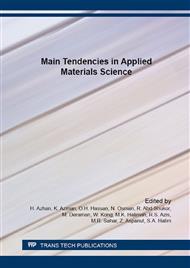[1]
N. Van Quy, V. Anh Minh, N. Van Luan, V. Ngoc Hung, N. Van Hieu. Gas Sensing Properties at Room Temperature of Quartz Crystal Microbalance Coated with ZnO Nanorods. Sensor & Actuator B 153 (2011) 188-193.
DOI: 10.1016/j.snb.2010.10.030
Google Scholar
[2]
R. Yousefi, B. Kamaluddin. The Effect of Annealig Temperature on Structural and Optical Properties of S-doped ZnO Nanobelts. Solid State Sciences 12 (2010) 252-256.
DOI: 10.1016/j.solidstatesciences.2009.11.002
Google Scholar
[3]
M. Rajabi, R. S. Dariani, A. Iraji Zad. UV Photodetection of Laterally Connected ZnO Rods Grown on Porous Silicon Substrate. Sensor & Actuator A 180 (2012) 11-14.
DOI: 10.1016/j.sna.2012.04.003
Google Scholar
[4]
M.H. Mamat, M. Z. Sahdan, Z. Khusaimi, A. Zain Ahmed, S. Abdullah, M. Rusop. Influence of Doping Concentrations on the Aluminum Doped Zinc Oxide Thin Films Properties for Ultraviolet Photoconductive Sensor Application. Optical materials 32 (2010).
DOI: 10.1016/j.optmat.2009.12.005
Google Scholar
[5]
S.S. Cetin, I. Uslu, A. Aytimur, S. Ozcelik. Characterization of Mg doped ZnO nanocrystallites Prepared Via Electrospinning. Ceramics International 38 (2012) 4201-4208.
DOI: 10.1016/j.ceramint.2012.02.003
Google Scholar
[6]
A.E. Jimenez-Gonzalez, J. A. Soto Urueta, R. Suarez-Parra. Optical and Electrical Characteristics of Aluminum-doped ZnO Thin Films Prepared by Solgel Technique. Journal of Crystal Growth 192 (1998) 430-438.
DOI: 10.1016/s0022-0248(98)00422-9
Google Scholar
[7]
Z. khusaimi, S. Amizam, M. H. Mamat, M. Z. Sahdan, M. K. Ahmad, N. Abdullah, M. Rusop. Controlled Growth of Zinx Oxide Nanorods by Aqueous-solution Method. Synthesis and Reactivity Inorganic, Metal-organic and Nano-metal Chemistry, 40: 190-194, (2010).
DOI: 10.1080/15533171003629147
Google Scholar
[8]
Q. Shi, Z. Wang, Y. Liu, B. Yang, G. Wang, W. Wang, J. Zhang. Single-phased Emission-Tunable Mg doped ZnO phosphors for White LEDs. Journal of Alloys and Compounds. 553 (2013) 172-176.
DOI: 10.1016/j.jallcom.2012.11.135
Google Scholar
[9]
R. Elilarassi, G. Chandrasekaran. Microstructural and Photoluminescence Properties of Co-doped ZnO Films Fabricated Using a Simple Solution Growth Method. Materials Science in Semiconductor Processing 14 (2011) 179-183.
DOI: 10.1016/j.mssp.2010.11.001
Google Scholar
[10]
Z. Ben Ayadi, L. El Mir, K. Djessas, S. Alaya. Effect of the annealing temperature on transparency and conductivity of ZnO: Al thin films. Thin solid films 517 (2009) 6305-6309.
DOI: 10.1016/j.tsf.2009.02.062
Google Scholar
[11]
M.H. Mamat, N. N. Hafizah, M. Rusop. Fabrication of thin, dense and small diameters zinc Oxide Nanorod Array-based Ultraviolet Photoconductive Sensors with High Sensitivity by Catalyst-free Radio Frequency Magnetron Sputtering. Materials Letters 93 (2013).
DOI: 10.1016/j.matlet.2012.11.105
Google Scholar
[12]
T. Prasada Rao, M.C. Santhosh Kumar. Physical Properties of Ga-doped ZnO Thin Films by Spray Pyrolysis. Journal of Alloys and Compounds 506 (2010) 788-793.
DOI: 10.1016/j.jallcom.2010.07.071
Google Scholar


